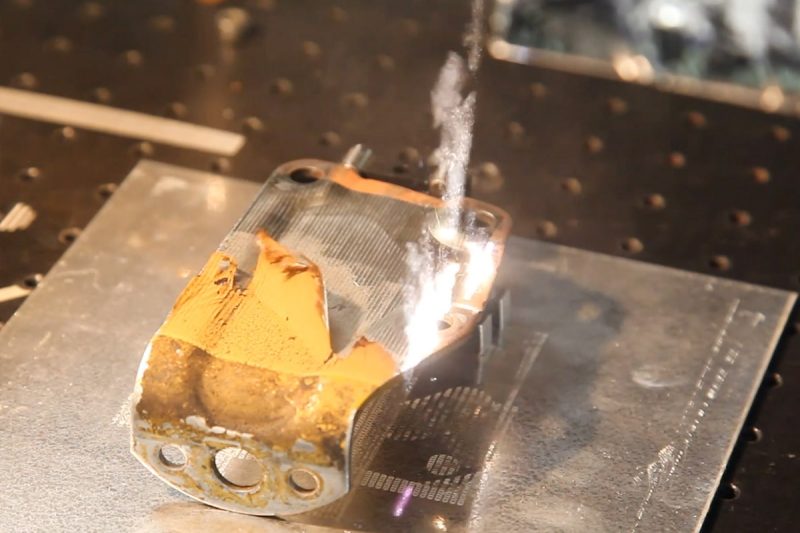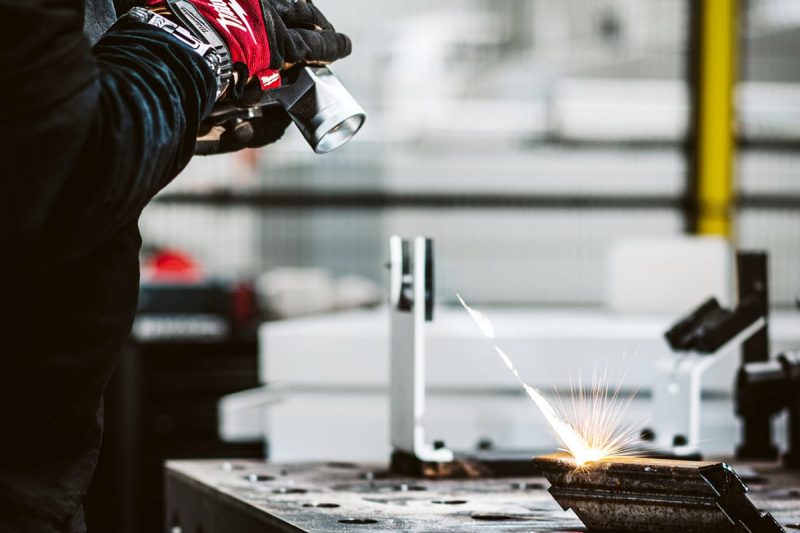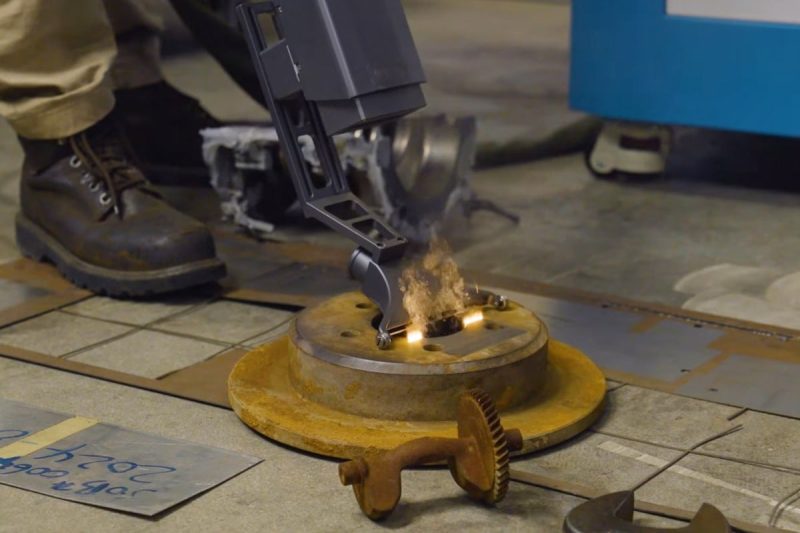

Introduction to Laser Cleaning Machines
Overview of Laser Cleaning Technology
Applications of Laser Cleaning Machines

Factors That Influence the Cost of Laser Cleaning Machines
Power Output
Type of Laser: Continuous VS Pulsed
Portability
Machine Configuration and Features
Cooling System
Automation and Integration
Control System and Software
Brand and Manufacturer Reputation

Price Ranges for Different Types of Laser Cleaning Machines
Pulse Laser Cleaning Machine
Pulse laser cleaning machines are designed for applications requiring precision and control. These machines emit short, powerful bursts of laser energy, making them ideal for delicate surfaces or tasks requiring high precision, such as cleaning mold tools, removing thin layers of contamination, or working on sensitive historical artifacts. Their advanced technology makes them more expensive than continuous laser machines.
- Price Range: Pulse laser cleaning machines typically start at around $7,000 for lower-power models (100W) and can go up to $80,000 or more for high-powered systems (up to 1000W), depending on additional features such as cleaning width adjustment, precision control, and cooling systems.
Continuous Laser Cleaning Machine
Continuous laser cleaning machines are designed for faster, large-area cleaning tasks. They emit a constant beam of laser energy, which makes them suitable for removing heavy contaminants such as thick rust, paint, or coatings from industrial equipment, ships, pipelines, or large structures. These machines are generally more affordable than pulsed systems but less suitable for highly sensitive cleaning tasks.
- Price Range: Entry-level continuous laser cleaning machines with lower power outputs (1500W) start at approximately $4,500, while high-powered models (2000W to 3000W) can cost between $80,000 and $50,000, depending on the power, cooling system, and any additional features such as automation.
Handheld Laser Cleaning Machine
Handheld laser cleaning machines are designed for portability and convenience. They are lightweight and easy to operate, making them ideal for tasks such as rust removal, paint stripping, or surface preparation in hard-to-reach areas or remote locations. These machines are particularly popular in industries like automotive repair, construction, and small-scale manufacturing.
- Price range: Handheld laser cleaners are generally more affordable, with entry-level models (100W pulse laser cleaning machines and 1500W continuous laser cleaning machines) costing $4,500-$7,000. Mid-range handheld systems (200-300W pulsed laser cleaning machines and 2000W continuous laser cleaning machines) cost between $5,500 and $15,000, while higher-end models with more power and advanced features (500W pulsed laser cleaning machines and 3000W continuous laser cleaning machines) can cost between $7,500 and $35,000.
Automatic Laser Cleaning Machine
Automatic laser cleaning machines are fully integrated systems that can be programmed for high-volume, repetitive cleaning tasks. These machines are often equipped with robotic arms, conveyor belts, and CNC-controlled systems for fully automated operation, making them highly efficient for industries with continuous production lines such as automotive manufacturing, aerospace, and heavy industry. Automation reduces labor costs and increases throughput, making these systems a significant investment.
- Price Range: Due to their advanced capabilities, automatic laser cleaning machines are among the most expensive options. Prices start around $40,000 for basic automated systems and can exceed $150,000 for large-scale industrial systems with high power outputs (1000W and above), extensive integration, and custom configurations.

Cost Breakdown of Laser Cleaning Machines
Upfront Purchase Cost
The initial purchase price is the most significant cost when acquiring a laser cleaning machine. This price depends on factors such as the machine’s power output, type of laser (pulsed or continuous), portability, and any additional features or customization options.
- Entry-level handheld laser cleaning machines can cost between $5,000 and $10,000, depending on the wattage and portability.
- Industrial-grade machines with higher power outputs can range from $15,000 to over $50,000.
- Fully automated systems integrated into production lines can cost upwards of $150,000 or more due to their complexity and additional robotic or CNC-controlled features.
Operational Costs
While laser cleaning machines are energy-efficient, there are still operational costs to consider, primarily in terms of power consumption and cooling requirements.
- Energy Consumption: The power usage depends on the wattage of the machine. Lower-power models (up to 100W) may consume relatively little electricity, while high-powered machines (1000W or more) will have higher energy demands, which can increase operational costs. Continuous laser cleaning machines generally consume more energy compared to pulsed systems.
- Cooling Systems: Machines with air-cooling systems are cheaper to operate than those with industrial water-cooling systems, which require more energy to maintain optimal operating temperatures for high-powered machines.
Maintenance Costs
Laser cleaning machines require minimal maintenance compared to traditional cleaning methods, but there are still some costs associated with keeping the machine in good working order.
- Laser Source and Optics: Over time, the laser source and optics may need to be replaced due to wear and tear. Replacing a laser source can cost between $1,000 and $5,000, depending on the machine’s power and brand.
- Cooling System Maintenance: Machines with water-cooling systems require periodic maintenance to ensure the cooling fluids remain effective. Maintenance for cooling systems can range from $500 to $2,000 per year.
- Software Updates: Some machines may require periodic software updates to improve functionality or integrate with newer systems. These updates are often provided by manufacturers like AccTek Laser but could come at an additional cost if not covered under warranty.
Training and Labor Costs
Operating a laser cleaning machine requires specialized training to ensure safe and effective use. While many manufacturers offer initial training, businesses may incur additional costs if further training is required.
- Initial Training: Many manufacturers, such as AccTek Laser, include basic operator training in the purchase price. However, if more advanced training is needed, costs can range from $500 to $2,000, depending on the complexity of the machine.
- Labor Costs: If the machine is operated manually, labor costs will also need to be considered. Automated systems can reduce labor requirements, but handheld or semi-automated machines will require skilled operators. Wages for machine operators can vary, with average costs of $20 to $50 per hour, depending on location and industry.
Upgrades and Add-Ons
As businesses grow or as technology advances, upgrading or adding features to a laser cleaning machine may become necessary. While these upgrades can enhance the machine’s capabilities, they come with additional costs.
- Additional Power: Some laser cleaning machines offer the option to upgrade to higher wattage for more powerful cleaning capabilities. These upgrades can cost between $10,000 and $30,000 depending on the increase in power and configuration.
- Automation Add-Ons: Businesses that initially invest in a semi-automated system may later choose to add robotic arms or conveyor belts for fully automated cleaning. These add-ons can range from $50,000 to $100,000, depending on the level of automation required.
- Custom Features: Options such as adjustable cleaning widths, 3-in-1 functionality (cleaning, welding, and cutting), or enhanced precision controls can increase costs by $1,000 to $2,000, depending on the customization.

Buying Considerations and Recommendations
Power Requirements
The power of a laser cleaning machine is a critical factor that directly impacts its performance and cost. Higher-powered machines are more suitable for heavy-duty cleaning tasks, such as removing thick rust or paint layers from large surfaces, while lower-powered machines are sufficient for lighter cleaning applications or delicate surfaces.
- For heavy-duty industrial cleaning: Machines with a power output between 1000W and 3000W are ideal. These systems provide faster cleaning speeds and can handle tough contaminants on metals, equipment, and large structures. However, they come at a higher cost.
- For small-scale or delicate tasks: Consider a lower-powered machine in the range of 100W to 500W, which is more affordable and provides the precision needed for cleaning fragile surfaces or intricate areas without damaging the base material.
Precision Needs
Precision is another important consideration, especially for industries where delicate surfaces or highly controlled cleaning is required. The type of laser—pulsed or continuous—will influence the machine’s precision and suitability for various tasks.
- For high-precision applications: Pulsed laser cleaning machines are the best option. They emit controlled bursts of laser energy, which allow for detailed cleaning without damaging sensitive surfaces. These machines are perfect for industries such as aerospace, electronics, or historical restoration.
- For large-area, fast cleaning: Continuous laser cleaning machines provide a constant beam, making them suitable for applications that require speed over precision. They are ideal for large-scale industrial projects where the primary goal is to remove heavy contaminants quickly.
Budget Constraints
Your budget plays a significant role in determining which type of laser cleaning machine you can afford. Machines come in a wide price range, from entry-level handheld units to high-end automated systems.
- For small businesses or budget-conscious buyers: A handheld laser cleaning machine with lower power output is a cost-effective option, typically ranging from $4,500 to $10,000. These machines are portable and versatile, suitable for general rust or paint removal tasks.
- For larger operations with bigger budgets: Industrial-grade systems or automated laser cleaning machines are the better choice, though they come with a higher price tag, often between $15,000 and $150,000. These machines provide faster cleaning speeds and are more suited to continuous production environments.
Manufacturer Support
One of the most overlooked aspects of purchasing a laser cleaning machine is the level of support provided by the manufacturer. AccTek Laser provides more than just a machine, we offer comprehensive support services to help ensure the long-term success of your investment.
- Warranty and After-Sales Support: Ensure that the manufacturer offers a solid warranty that covers major components such as the laser source and optics. After-sales support helps troubleshoot and maintain machine performance.
- Training and Setup Assistance: Look for manufacturers that offer training to your staff, either in-person or remotely, as part of the purchase package. Proper training helps avoid operational errors and ensures that you maximize the machine’s potential.
- Technical Support and Spare Parts Availability: Choose a manufacturer that provides ongoing technical support and easy access to spare parts. This ensures that if an issue arises, it can be addressed quickly, minimizing downtime.

How To Choose The Right Laser Cleaning Machine for Your Budget
Assess Your Cleaning Requirements
The first step in choosing the right laser cleaning machine is to evaluate your specific cleaning needs. The type of material you need to clean, the level of contaminants, and the frequency of cleaning tasks will determine the machine’s required power and features.
- For light-duty or small-scale applications, such as rust removal from small components or surface preparation, a lower-powered, handheld machine (100W to 300W) will be more than sufficient. These models are budget-friendly and offer enough power for general maintenance tasks.
- For industrial-scale or heavy-duty cleaning, such as removing thick layers of paint, rust, or coatings from large surfaces, a more powerful machine (500W to 3000W) may be necessary. These machines offer faster cleaning speeds and can handle more challenging contaminants, but they come at a higher price point.
Compare Different Types of Laser Cleaning Machines
Laser cleaning machines come in various types, each with different price ranges and capabilities. Understanding the differences between handheld, pulsed, continuous, and automatic systems is crucial when working within a specific budget.
- Continuous Laser Cleaning Machines: If your application requires faster cleaning for large surfaces, a continuous laser machine may be the best choice. While these machines are expensive, starting at $4,500, they are highly effective in industrial settings.
- Pulsed Laser Cleaning Machines: For high-precision tasks, such as delicate surface restoration, pulsed lasers are ideal. Prices for these machines start around $6,500, making them a good option for applications where precision is a priority over speed.
Factor in Long-Term Costs
In addition to the upfront purchase price, it’s essential to consider the long-term operational and maintenance costs when selecting a laser cleaning machine. Machines with lower initial prices may require more frequent maintenance or higher operating costs, while more expensive models may offer better efficiency and lower upkeep.
- Energy Efficiency: Higher-powered machines consume more electricity, which can increase operational costs. Compare energy consumption between models to find the most cost-effective option for your budget.
- Maintenance: While laser cleaning machines typically require minimal maintenance, replacing components such as the laser source or optics can be costly. Opt for a machine that offers a solid warranty and low maintenance needs to minimize long-term expenses.
- Training: Make sure to account for any training costs required to operate the machine. Some manufacturers, like AccTek Laser, include training in the purchase package, while others may charge extra for this service.
Consider Additional Features
Additional features and customizations can significantly impact the overall cost of a laser cleaning machine. While these extras can enhance the machine’s performance, they may also add to the price. Consider whether you truly need these features or if a more basic model will meet your requirements.
- Adjustable Cleaning Widths: If your application requires versatility, a machine with adjustable cleaning widths may be worth the added investment. However, for basic cleaning tasks, this feature might not be necessary.
- 3-in-1 Functionality: Some laser cleaning machines also offer welding and cutting capabilities, which can increase the price. If your operations require multiple functions, this could be a cost-effective solution; otherwise, you may want to opt for a standard cleaning-only model.
- Automation: If labor costs are a concern and you require continuous production, investing in an automatic laser cleaning machine may provide long-term savings by reducing manual intervention. However, if your budget is limited, a handheld or semi-automated system might be more practical.
Prioritize Manufacturer Support
When making a significant investment like a laser cleaning machine, the level of support from the manufacturer should be a priority. A reputable manufacturer, like AccTek Laser, provides comprehensive support, including training, warranty, and technical assistance, which can save you money and time in the long run.
- Warranty: Ensure that the machine comes with a robust warranty, especially for critical components like the laser source. A good warranty reduces the risk of unexpected repair costs.
- Technical Support: Choosing a manufacturer that offers 24/7 technical support and easy access to spare parts ensures minimal downtime in case of malfunctions. This level of support can be invaluable in maintaining the efficiency of your operations.

Why Are Laser Cleaning Machines So Expensive?
Advanced Laser Technology
Customization and Versatility
High-Quality Components
Laser cleaning machines are made with high-quality components to ensure durability and efficiency in demanding industrial environments. From the laser source and optics to cooling systems and control interfaces, each part must be reliable and capable of performing under heavy use.
- Laser Source: The laser generator is one of the most expensive components of the machine. High-power fiber lasers, used in continuous and pulsed systems, are robust and durable but costly to manufacture.
- Cooling Systems: High-powered laser cleaning machines require industrial water cooling systems to maintain safe operating temperatures. These cooling systems are advanced and contribute significantly to the overall cost, especially in machines designed for heavy-duty applications.
- Control Systems and Software: Laser cleaning machines often include sophisticated control software that allows operators to adjust the cleaning process for specific tasks. These user-friendly interfaces and automation features add to the machine’s overall price.
Precision and Efficiency
Automation and Integration
Research and Development
Long-Term Savings

Will The Price of Laser Cleaning Machines Drop in The Future?
Technological Advancements and Manufacturing Efficiency
Increased Competition in the Market
Wider Adoption Leading to Economies of Scale
Potential for Lower-Power, Cost-Effective Solutions
Cost of Raw Materials and Economic Factors
Improved Automation and Reduced Labor Costs
Long-Term Price Stability for High-End Models

Summary

Get Laser Solutions
- [email protected]
- [email protected]
- +86-19963414011
- No. 3 Zone A, Lunzhen Industrial Zone,Yucheng City , Shandong Province.

